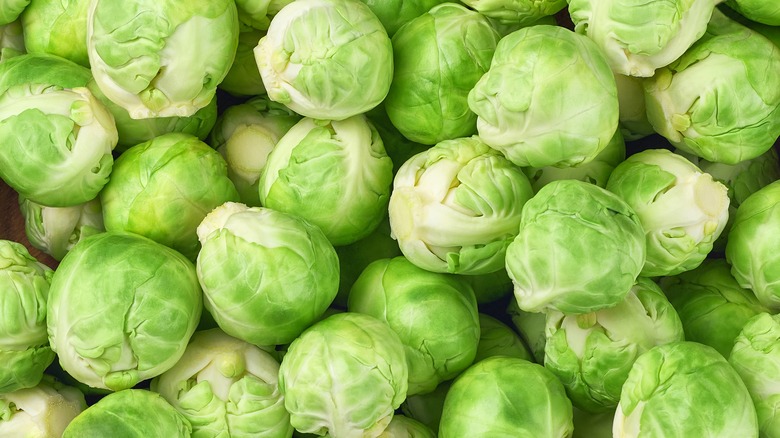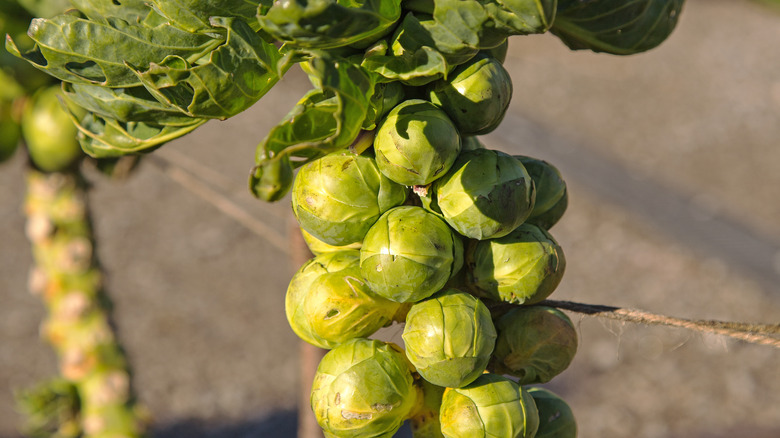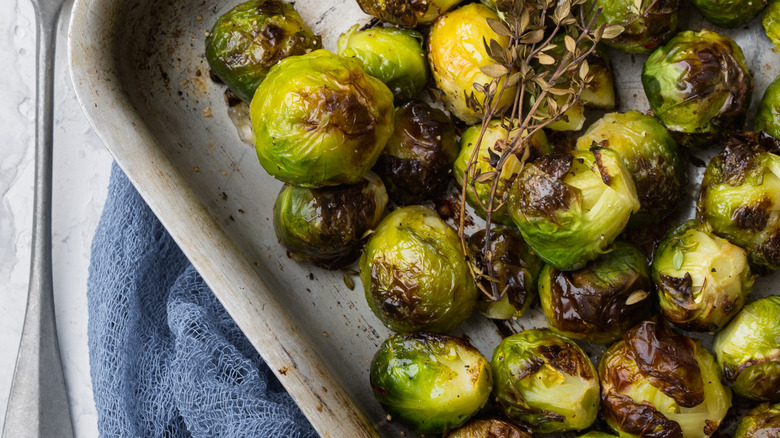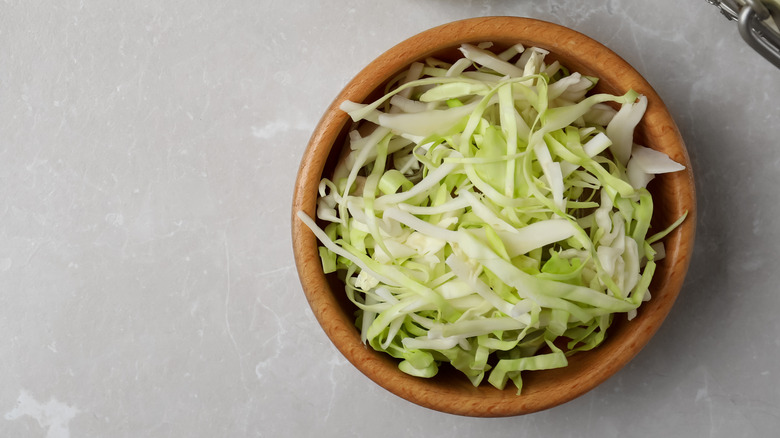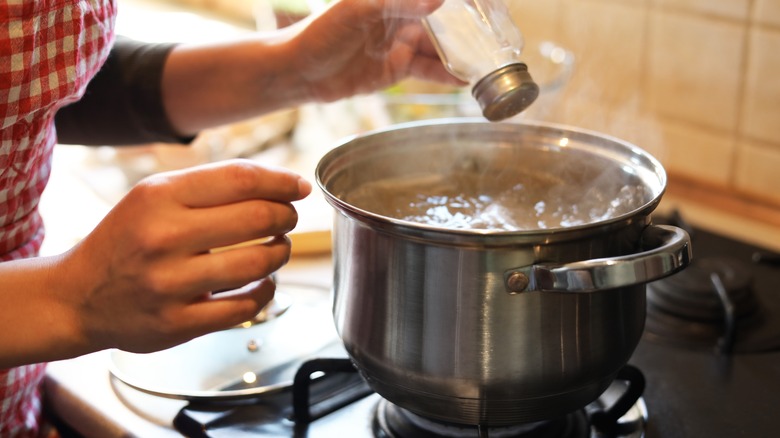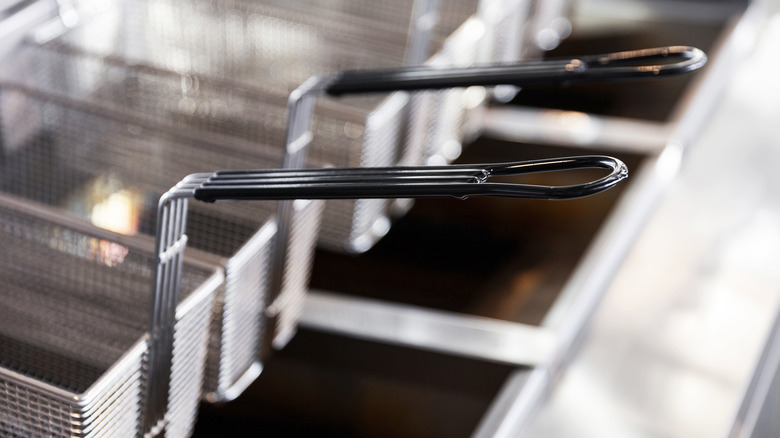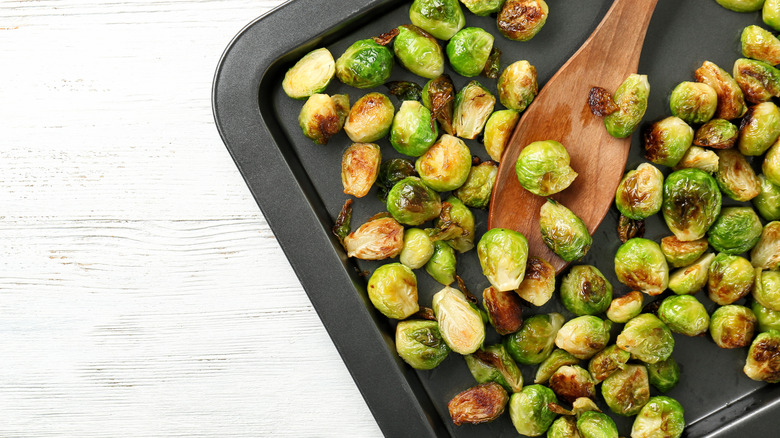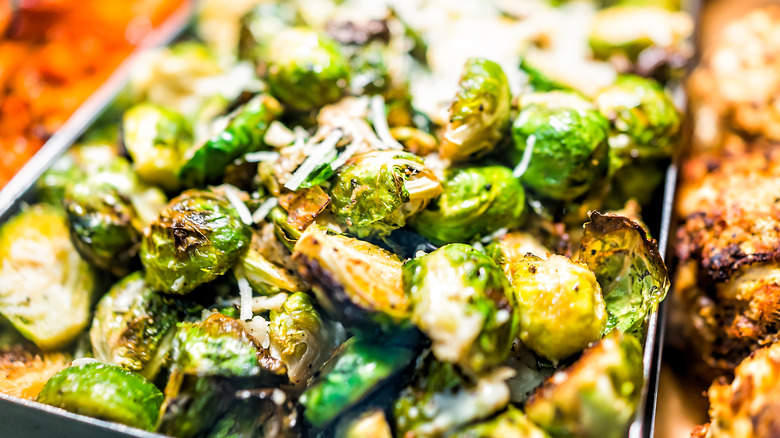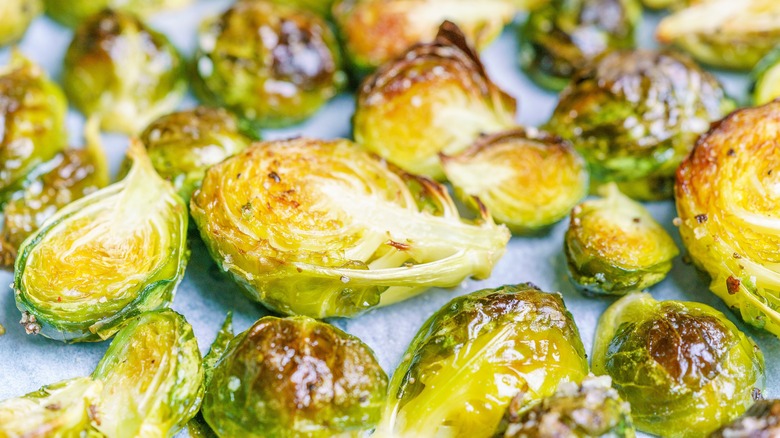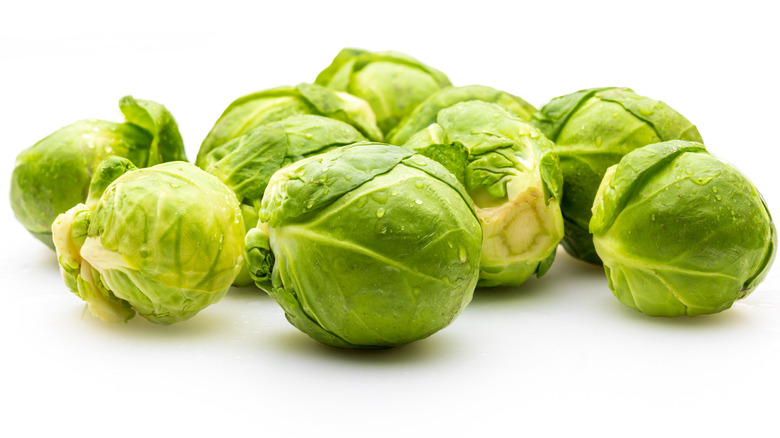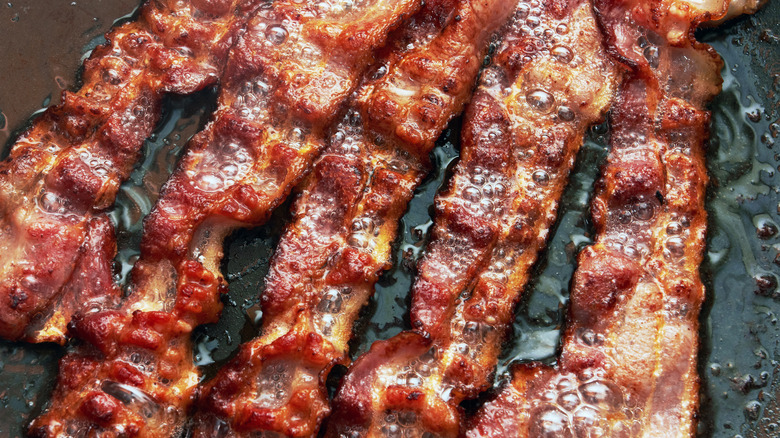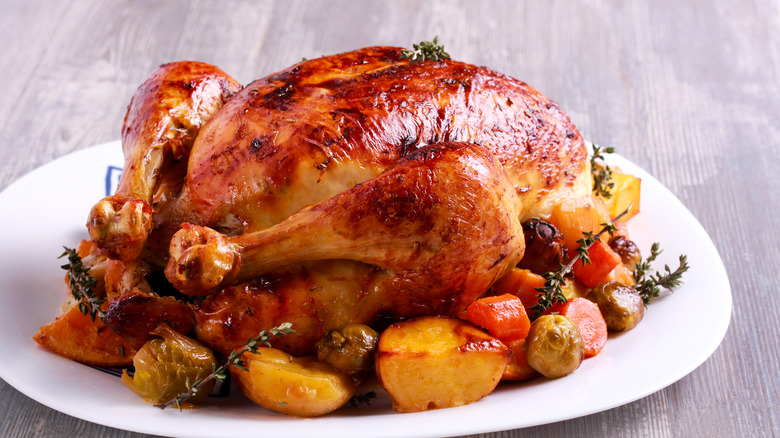12 Tips You Need For Delicious Brussels Sprouts
Brussels sprouts are one of those foods that people feel very strongly about: They either love them or hate them. We think that if you fall into the latter camp, well, maybe you just haven't had them prepared the right way yet.
These diminutive cabbage heads owe their trademark bitter flavor that creates such divisiveness to the fact that they're part of the Brassicaceae family, also called the mustard family. This group includes radishes, the sinus-clearing wasabi we dab on sushi, bitter-spicy arugula, and members of the cabbage family. Broccoli, cauliflower, kale, and of course, cabbages are close relatives to Brussels sprouts.
Making delicious Brussels sprouts depends on knowing how to choose and prepare them properly, picking the best cooking methods (Hint: it's not boiling frozen sprouts like our parents used to do), and knowing what flavors and seasonings pair best with that earthy and bitter flavor for which Brussels sprouts are known.
Use our tips for delicious Brussels sprouts, and you'll be able to sway even the staunchest haters.
Choose the freshest Brussels sprouts
Delicious Brussels sprouts recipes start with knowing how to choose the best-quality Brussels sprouts at the store or farmer's market. As with many vegetables, buying Brussels sprouts when they're at the peak of their season will give you the freshest sprouts and the best flavor. In colder climates, peak harvesting season is in the fall or early winter. In warmer parts of the country, Brussels sprouts are planted later in the season and will be at their peak in mid or late winter.
When you're shopping, pick firm, tightly packed sprouts with little to no yellowing. Choosing the freshest sprouts, particularly if you can buy them at a farmer's market where it's likely that the day before they were still on their stalks in the field, will ensure that you can maximize their many nutritional benefits since nutrients can degrade in fruits and vegetables when a long period of time passes between harvesting and eating. And you won't want to miss out on the many healthy qualities that Brussels sprouts possess: They are high in antioxidants and fiber and have anti-inflammatory properties, among other benefits.
Pick out evenly sized sprouts for even cooking
When you're filling your produce bag with Brussels sprouts, try to select sprouts that are all a uniform size, especially if you plan to cook them whole. As with most vegetables, it's important that pieces of food are of a similar size when preparing them for cooking, whether you're roasting, sauteing, or boiling. Shop at grocery stores that sell Brussels sprouts by the pound, so you can select each sprout yourself, rather than in pre-bagged portions.
This attention to detail will reward you in a big way: The Brussels sprouts will all cook at an even rate. You won't end up with some pieces that are overcooked, while others are still hard in the middle.
If you end up with a bag of Brussels of varying sizes, you can halve the bigger pieces (cut them lengthwise through the core so the leaves will stay attached). This will help even up the pieces so they'll all be finished cooking at around the same time.
Of course, no matter how careful you are, you might still end up with a few sprouts that are larger than the rest. Start checking for doneness early by spearing a sprout with a fork to test if the center is tender. If some of your smaller sprouts seem like they're cooked through and in danger of getting overdone, remove them from the pan and put them in a serving bowl covered with aluminum foil while the remainder cooks.
Shave them into a salad or sauteed dish
Many recipes call for Brussels sprouts to be used whole or halved, but shredding their leaves gives sprouts a whole new personality (and is a favorite preparation method of Ina Garten). The leaves become tender and delicate. While you certainly wouldn't nosh on a whole raw sprout, the shredded sprouts are palatable enough to be eaten raw.
For shaved or shredded Brussels sprouts, use a chef's knife or a mandoline slicer to thinly slice the sprouts crosswise, beginning with the tip of the head and stopping at the thick stem. Pressed for time or unsure of your knife skills? Try shredding the sprouts using the slicing disc of a food processor, or look for packages of shredded Brussels sprouts in the produce department of your supermarket.
Fans of cabbage will love giving sprouts the salad treatment. Toss the shreds with a dressing and other ingredients for a fresh and tasty side dish. We're partial to combining shredded sprouts with chewy dried fruit like candied ginger or dried cranberries, a crunchy component like chopped pecans or pepitas, and a tangy vinaigrette.
Sautéing shaved Brussels sprouts is another quick and easy side dish option that takes a fraction of the time of roasting. Try sautéing shredded sprouts in olive oil and finishing with salt, pepper, and lemon.
Give them a salt bath
Sometimes Brussels sprouts can have a bitter flavor and a strong odor, which can be exacerbated if they're overcooked. It's these less-than-pleasant characteristics that have earned Brussels sprouts a dubious reputation among some folks. But there's an easy fix for a milder, less odiferous result: parboiling Brussels sprouts. This cooking technique simply means to partially cook food in boiling water. This method hastens the cooking time, which in turn minimizes the amount of time needed to sauté or roast the sprouts.
To parboil your Brussels sprouts, bring a pot of water to a boil and add salt, about the same amount as you might add to pasta cooking water. Prepare the sprouts by trimming a sliver off the stem end. When the water comes to a boil, add the sprouts and cook them for up to two minutes. Remove them with a slotted spoon or a strainer. The sprouts will only be partially cooked at this point, so you can continue with your recipe, whether it's roasting or sautéing your sprouts. Patting the sprouts dry before roasting or sautéing will ensure they crisp up nicely instead of steaming and becoming soggy.
Toss Brussels sprouts in the fryer (or the air fryer!)
Deep-fried Brussels sprouts seem to be on every menu these days, from ramen restaurants to burger joints, and for good reason. Deep frying transforms Brussels sprouts into a crispy-edged treat with a tender center — the perfect vehicle for a generous sprinkling of sea salt or a drizzling of something more exotic like an Asian soy-ginger sauce. Brussels sprouts are definitely one of the fried foods you need to try before you die.
If you want to try your hand at making deep-fried Brussels sprouts as you've enjoyed at your favorite izakaya, be sure to follow the proper techniques for deep frying. Use a neutral oil with a high smoke point, make sure it's at the right temperature, and dry your sprouts as much as possible before dropping them in their hot-oil bath, since water can cause the cooking oil to deteriorate, which will affect the flavor and texture of the food.
If this all sounds intimidating to you, turn to your air fryer for similar (and healthier!) results. Brussels sprouts are one of those foods that seem tailor-made for an air fryer, which produces a sprout with crispy exterior leaves and a nice tender center, and it takes less than 20 minutes, about half as long as oven-roasted sprouts.
Perfect your roasting technique
Those who grew up on mushy boiled Brussels sprouts are often pleasantly surprised to taste roasted sprouts, which become earthy and complex in the oven. While your recipe can be as simple as tossing your sprouts with olive oil, salt, and pepper, knowing the proper roasting technique will ensure that your roasted Brussels sprouts come out perfectly tender and delicious.
Halving Brussels sprouts lengthwise will help the dense core cook more evenly and will create more surface for the sprouts to caramelize and crisp up. Make sure to toss sprouts with a generous amount of olive oil, which also will encourage browning. You could also try celebrity chef Guy Fieri's hack for roasting perfectly crisp Brussels sprouts: He stacks an ovenproof cooling rack on top of the baking pan, which lets hot air circulate around the sprouts to make them both crisp and tender.
Finishing the roasted sprouts with flavorful seasonings is a must, even if it's as little as a drizzle of balsamic vinegar, a squeeze of lemon, or a sprinkling of salt and pepper. We love the simple, yet complex flavors in tamari-roasted Brussels sprouts.
Get creative with flavor combinations
Brussels sprouts have a distinctive flavor that ranges from bitter to earthy to slightly sweet, depending on their size and how you prepare them. Their distinctive flavor lends itself well to some interesting flavor combinations when they're roasted, sautéed, or enjoyed raw. Think about other foods that have similar flavors and what flavors you think best complement these. For instance, beets also have an earthy flavor profile and often are complemented with a rich butter or nutty parmesan cheese, two ingredients that would also go great with Brussels sprouts. And bitter flavors are often offset by sweet ones, which means maple syrup has become a classic counterpoint for Brussels sprouts.
"The Flavor Bible" by Andrew Dornenberg and Karen Page, a guide to flavor combinations for just about any ingredient, also has some unexpected but winning flavor combinations that can serve as a base for experimentation. Next time you're winging it in the kitchen, try pairing your Brussels sprouts with some of Dornenberg's and Page's recommendations, like apple cider (or apple cider vinegar), blue cheese, hazelnuts, pancetta, or cream.
Try preheating the pan
Raise the bar on your roasting game with this simple trick: Put the baking sheet in the oven as it preheats. When the oven's hot enough, take the pan out, spread your Brussels sprouts on the hot pan, and put it back in the oven.
Why does this make a difference? The heat from the pan will get to work immediately, searing the underside exterior of the sprouts. The sprout will also cook more evenly, and you'll end up with a crispier exterior.
Along with starting with a hot pan, there are two more tips you can try that will contribute to the best roasted Brussels sprouts. First, make sure your Brussels sprouts are completely dried before cooking. And second, spread them out on the pan so they're evenly spaced out in a single layer with a little space between them. Taking the time to follow these steps will yield the delicious browning and caramelization that's the hallmark of perfectly roasted Brussels sprouts.
Consider the size of your sprout
Who would have thought that size matters, even when it comes to Brussels sprouts? It's true: The size of a sprout can dictate how it tastes. Next time you're shopping for Brussels sprouts, think about your flavor preferences and shop at a store that sells sprouts by the pound so you can cherry-pick the size of sprouts you prefer.
If you like your sprouts to have a sweeter, milder flavor, pick out Brussels sprouts that are smaller in size. If you want to ramp up the bitter flavor profile of your recipe, though, choose the larger sprouts, at least an inch in diameter. Larger brussels sprouts are also easier to work with if you're shredding them for a salad or a sautéed dish.
The size of the sprouts also has an effect on cooking time. Smaller pieces will cook through faster, while larger sprouts will need more time.
Pair Brussels sprouts with bacon
Whatever method you use to cook Brussels sprouts — even boiling — combining them with bacon is always a good idea. (And we contend that combining just about anything with bacon is a good idea!)
Salty, smoky, crispy bacon is a classic counterpoint to the earthy, bitter flavor of Brussels sprouts. This makes sense, considering that salt can suppress bitter flavors.
Try chopping up and frying a slice of bacon in a skillet, removing the bacon from the pan, and using the remaining bacon fat to sauté halved Brussels sprouts. Other options: save a piece of bacon from breakfast to crumble over steamed Brussels sprouts or make a bacon vinaigrette for a shaved Brussels sprouts salad. We also love adding bacon to the pan while roasting Brussels sprouts (Check out the recipe for maple bacon Brussels sprouts). With bacon, a little can go a long way to truly elevate a Brussels sprout dish.
Use Brussels sprouts as a bed for roast chicken
It's a well-known technique to line a roasting pan with carrots, onions, potatoes, and other vegetables and roast a chicken on the veggie bed. Doing so serves two purposes. First, it elevates the chicken so hot air can circulate around it and crisp up the skin evenly. Second, the drippings from the chicken will flavor the veggies below. Voila! A side dish that's ready at the same time as the main course.
The same technique can be used with Brussels sprouts, which are the perfect size for this purpose. Use small whole sprouts, or halve larger ones, and spread them over the bottom of a roasting pan, either on their own or with other vegetables that are cut to be similar in size. Toss them with a little olive oil and sprinkle with salt and pepper, then set a whole chicken on top, cooking until the chicken's internal temperature is 165 degrees Fahrenheit. The bitter flavor of the sprouts is a perfect counterpoint to the rich flavor of the chicken, especially when both are seasoned with plenty of salt and pepper.
Try Jamie Oliver's secret ingredient for Brussels sprouts
Jamie Oliver has a secret ingredient he adds to Brussels sprouts: Worcestershire sauce. Oliver's recipe combines the sprouts with apples, sausage, and sage, finished with a tablespoon of the British condiment, per the recipe on his website. Worcestershire sauce, which is based on fermented anchovies and has a rich umami flavor, can add depth and dimension to everything from burgers to Bloody Marys. So it shouldn't come as a surprise that the briny saltiness of the sauce goes great with the flavor of Brussels sprouts.
Don't have Worcestershire sauce on hand? Next time you make Brussels sprouts, you can take flavor inspiration from the funky-salty condiment and find a good substitute, such as soy sauce or fish sauce. Just don't serve Brussels sprouts seasoned with Worcestershire sauce to vegetarian dinner guests: The condiment contains anchovies, according to the ingredient list from manufacturer Lea & Perrins. Of course, you can always make an anchovy-free copycat version of Worcestershire sauce that's vegan-friendly.
